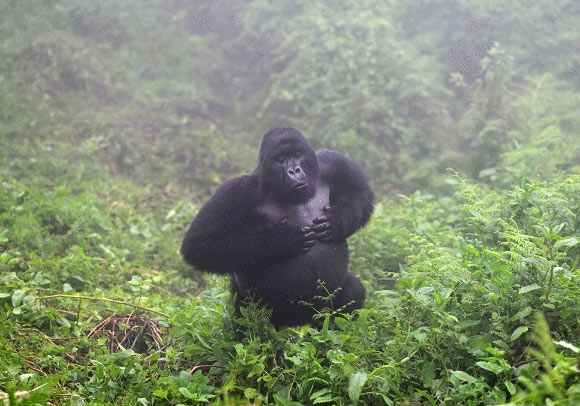The chest beat of male mountain gorillas (Gorilla beringei beringei) is an honest signal of body size, according to a paper published in the journal Scientific Reports.

Mountain gorilla silverback chest beating. Image credit: Wright et al., doi: 10.1038/s41598-021-86261-8.
Among the most emblematic sounds in the animal kingdom is the chest beat of gorillas, a signal that is thought to be important in intra- and inter-sexual competition.
Although it had previously been suggested that gorillas do this to convey information, the exact nature of that information was unclear.
“The gorilla chest beat is one of those iconic sounds from the animal kingdom, so it is great that we have been able to show that body size is encoded in these spectacular displays,” said lead author Dr. Edward Wright, a researcher at the Max Planck Institute for Evolutionary Anthropology.
“The chest beating behavior is typical of gorillas and had always been described as a display of strength related to social status and threatening behaviors,” added co-author Dr. Jordi Galbany, a scientist in the Department of Clinical Psychology and Psychobiology at the University of Barcelona and the Department of Anthropology at the Center for the Advanced Study of Human Paleobiology at the George Washington University.
“This kind of behavior is the climax of a demonstration: the gorilla starts making vocalizations similar to short howls, it gets on its foot and runs while beating its chest with both hands, making an impressive drummer-like sound.”
“Male gorillas beat their chests once every twenty hours under observation, but they can do so every few minutes when there is interaction between two groups of gorillas,” he added.
“This behavior is more common during the days when a female gorilla is in heat.”
Dr. Wright, Dr. Galbany and their colleagues observed and recorded 25 wild, adult male silverback gorillas monitored by the Dian Fossey Gorilla Fund in Volcanoes National Park, Rwanda, between January 2014 and July 2016.
“Conducting this study was challenging because the chest beats are relatively short in duration and we needed to be in the right place at the right time to obtain the sound recordings, as well as staying clear from these large powerful animals,” said co-author Eric Ndayishimiye, a researcher with the Dian Fossey Gorilla Fund.
The researchers examined the relationship among body size (back breadth), peak frequency, and three temporal characteristics of the chest beat: duration, number of beats and beat rate from sound recordings of wild adult male mountain gorillas.
They found that the audio frequencies of chest beats made by larger males were significantly lower than those made by smaller males.
Larger males may have larger air sacs near their larynx, which could lower the frequencies of sound they produce while chest beating, according to the authors.
Variations were also observed in the duration and number of chest beats made by different gorillas.
These were unrelated to body size but may allow chest-beating individuals to be identified.
“The sound of chest beating may allow mountain gorillas to communicate across the dense, tropical forests in which they live, where it is often difficult for them to see one another,” the scientists said.
“The mountain gorillas may use the information conveyed through chest beats to inform mate choice and to assess the fighting ability of competitors.”
_____
E. Wright et al. 2021. Chest beats as an honest signal of body size in male mountain gorillas (Gorilla beringei beringei). Sci Rep 11, 6879; doi: 10.1038/s41598-021-86261-8







